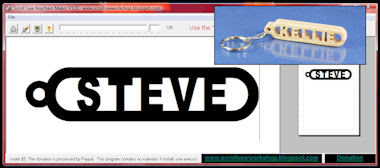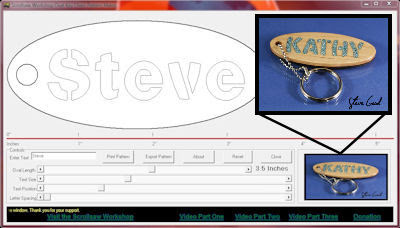Download Below
The holidays are fast approaching. Family and friends will be visiting. You have to have snacks ready. This snack tray is large enough to hold small snacks like peanuts, raisins, M&M's, and pretzels. If you want to go a bit more healthy then baby carrots and dip in a small bowl should work.
You can also enlarge the pattern for more capacity.
This is a really simple pattern but it is also useful and nice looking. The project is cut from 3/4" and 1/4" thick wood. I used walnut but a less expensive wood will work fine. You can use thicker than 3/4" if you need a deeper tray.
Don't be overly concerned about trying to use a "food safe" finish. All modern finishes are "food safe" once they are completely cured. Cured is different than dry. To cure some finishes can take a few days. to clean it's best to just wipe out the tray with a damp paper towel.

I received an email with an interesting question.
The question sounds easy but the answer is actually pretty complex. "How do I know what direction the grain of the wood should run on a project?"
When I tried to respond to the email I realized that the explanation was going to take a few paragraphs. I have always paid attention to the grain direction but never tried to write down rules. It is tougher than it sounds. Here are a few thoughts. This is absolutely not comprehensive. Furniture makers have to consider expansion and contraction of the wood. As scroll saw artists we rarely have to take than into consideration.
Sometimes the grain just looks more pleasing in one certain direction. In the case of the leaf above it looks more natural for the grain to run along the length of the leaf. I don't seem to be able to define this as a rule. I just know when it looks right. The leaf on the right looks odd.
The strength of the project can be compromised if you choose the wrong directions for the grain. The two spoons above are an example where you would choose the direction of the grain to help prevent the project from breaking. If you used an open grain wood and ran the grain in the direction of the top spoon it would probably break at the base of the bowl when any pressure was applied.
Some scroll saw patterns will have thin areas going in multiple directions. It can be difficult to choose the grain direction in such patterns. In those cases, you want to choose a wood that has tight grain for better strength. That is why I seldom use red oak. Red oak has a very wide grain and breaks easily if you get it too thin.
Sometimes it is structural and aesthetics. A frame is stronger when the grain runs the length of the rails and stiles. It also looks better. A frame would look very odd if the grain ran cross direction of one of the parts. Because the joints of a frame are end grain to end grain they are weak. You often have to add mechanical fasteners at the joints for strength. There are always trade-offs and compromises when choosing grain direction.
Intarsia artists use the grain of the wood to suggest form and depth. Notice how the artist used the grain to suggest the flow of the hair in this wolf. They are less concerned with the strength because all the pieces will be glued down to a backer board. They use the grain as an artistic medium.
I did a little research to see if anyone has compiled a set of rules for choosing grain direction. I did not find a list. I think there are just too many variables to set down a list of rules. You have to consider strength and aesthetics together and sometimes/often it is a compromise between the two.

$12 per sheet of 12 coins plus $3.50 shipping
Inlay with a 1" Forstner Bit.
The perfect way to sign your work.

Email Newsletter Readers: Remember that the Newsletter is just a copy of the daily blog post. To see the post in it's proper formatting click this link. If you ever misplace a pattern or any item you see here you can always find it on the blog. Everything stays on the blog forever.
Every Scrollsaw Workshop Pattern from 2007-2018 in DVD
Purchase the entire Scrollsaw Workshop pattern catalog for offline access.
This DVD has over 2,600 patterns published from 2007 thru 2018.
The DVD is $20 plus shipping. Ships to 60 countries around the world.
The DVD is $20 plus shipping. Ships to 60 countries around the world.
If you use the DVD on a Windows PC there is a simple viewer program to browse through the patterns.
The DVD also works fine on a MAC. The viewer program is not MAC compatible but there is an included PDF with all the patterns shown as thumbnails for easy viewing.
All the same file but on an easy to use a thumb drive. The USB thumb drive option is $23 plus shipping.
Now Available on USB Thumb Drive
Don't have a DVD drive on your new computer. No problem. Buy the catalog on a USB thumb drive.All the same file but on an easy to use a thumb drive. The USB thumb drive option is $23 plus shipping.
Scroll Saw Pattern Design Tutorial: DVD
Let me teach you to create a beautiful wooden portrait pattern. I will show you everything you need from start to finish. The video will show you the free software program you can download for Windows or Mac OS. I will show you how to install the program and configure it for best results.
Let me teach you to create a beautiful wooden portrait pattern. I will show you everything you need from start to finish. The video will show you the free software program you can download for Windows or Mac OS. I will show you how to install the program and configure it for best results.
Then I will show you the technique to take your photograph and make a pattern from it. When the pattern is complete we will go in the shop and cut it.
The DVD is $10 plus shipping. This is a data DVD that you will use on your computer to watch the video tutorial
My two "Wooden Vases on the Scroll Saw" books make it easy.
The books are $12 each and available for instant download after purchase. Click for Video Demonstration.
My Sponsors:
Support the businesses who support our community.
Home of Pegas scroll saw blades.
 Ad: Affiliate
Ad: AffiliateStanley 31610 SurgeMax Pro 9 Outlet Metal Surge Protector, Black
Great for workbenches.
SHOPMAX PRO 9
Unlike many other metal surge bars in the marketplace constructed of aluminum, the STANLEY SHOPMAX 9 casing is constructed entirely of a heavy duty steel, providing the strength and reliability you expect from STANLEY products.







































